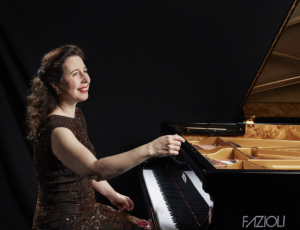
Buying a piano is a highly personal decision – besides the tonal character of the piano, and touch/feel preferences, there’s one selection criteria that should stand above all the rest, and that is how resonant the piano is.
So what does that mean, exactly?
Resonance refers to how long the piano’s soundboard will sustain notes across the entire 88 keys of the piano. In a resonant piano, those notes will sound and die off very slowly. In a less resonant piano, the sound will die off more quickly, which has a less than desirable affect on notes you want to sustain or sing for longer durations. In the treble area (starting at middle c through F- C7 where most melodies are played) is where a less resonant soundboard becomes a liability, which compromises the piano’s ability to provide the necessary sustain needed in this section of the piano.
So how do you listen for resonance? Here’s what a trained technician will do, known as the “pluck test” which you can also do for yourself:
Locate any string within the 5th or 6th octave ranges. With sustain pedal engaged, pluck the string with enough force to generate a clear tone. Listen and time (in seconds) how long it takes for that tone to slowly decay and disappear entirely. A resonant piano will yield a decay length of 15 seconds or more in the mid-treble section. As the strings get shorter in length into the high treble, you can expect shorter sustain.
You can also perform the pluck test on multiple pianos in a showroom – if the pianos all have acceptable tunings and well adjusted actions, it will be evident which piano(s), have the longest sustains.
Are older pianos less resonant, and should they be avoided?
This question is a hotly debated issue between piano manufacturers and seasoned piano technicians. Piano manufacturers, naturally, have a vested interest in consumers buying NEW pianos – their business model doesn’t support the sale of used instruments, which they are often competing against. We service and have evaluated many pianos that are 40-100 or more years old that sound heavenly, with ample resonance. Typically, these pianos are in environments with relatively consistent temperature and humidity, which provide a stable environment which minimizes soundboard expansion and contraction, that over time, can compromise the sound quality of the instrument.
While a piano’s action can be customized to increase or decrease the lightness or heaviness of touch, and hammers can be voiced to produce less or more brilliance, there’s really not much that can be done to improve a piano with limited resonance. There are a few reasons for this, mainly due to the individual characteristics of soundboards where no two are ever alike, the condition of the bridges, and unique patterns of soundboard woodgrain that impact the sustain. In other words, even if the piano plays exactly as you like, and has the perfect tone, if the soundboard isn’t generating enough sustain, it would be wise to continue your search.
We’ve evaluated pianos for clients that had extraordinary sustain, but whose actions were too heavy or too light, or were either too bright or muted. In these instances, we advised the piano was worth serious consideration, since we would be able to bring the tone and/or the action to the exact liking of the client. Pianos like this are like “diamonds in the rough” where the proper action regulation and/or hammer voicing bring the piano to its fullest potential. Sometimes a dealer will factor in an allowance for such work, as might a private party seller.
We perform two levels of piano evaluation: 1. Thorough documentation of every aspect of a piano, and 2. Basic inspection, but both cover an analysis of the piano’s resonance. If you have a piano you’re considering buying that you’d like us to evaluate, don’t hesitate to contact us.




